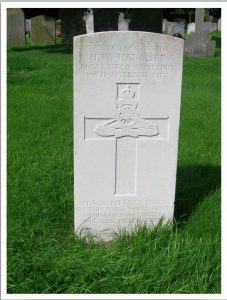49th Reserve Brigade, Royal Field Ambulance

Henry (Harry) Wallace Hancliff was born in Warwick in the second quarter of 1874 and was the son of William Edward (a builder’s shop foreman) and Ellen Hancliff. The couple had six children, Louisa, Emily, Harry, Rosina, Florence and Walter.
William died in 1887, aged 53, whilst the couple lived in the Tewkesbury area: Ellen having been born in Twyning.
No doubt family economic pressures, due to the death of his father, prompted Harry to join the Army and he enlisted at Tewkesbury on 6 February 1900, joining the Royal Field Artillery (RFA) (service number 4503). It appears likely that he was already a carpenter at that stage and made use of his skill, as a wheelwright in the RFA.
He appears to have served for about 12 years before going into the Reserve but it is not known if any of this service was abroad.
At the time of the 1911 Census he was back home at Church End, Tewkesbury, possibly on leave as sole companion to his mother. His stated occupation was ‘carpenter’.
On 22 May 1912 he got married to Louisa Florence Gardner at Tewkesbury Registry Office and on 10 February 1914 they had a son, Henry Thomas, born at Hill End, Twyning.
Soon after the declaration of war Harry was recalled to the Army, re-joining the Royal Field Artillery at Hilsea on 1 January 1915. Interestingly, on his attestation papers he declared his age to be ‘38 years and 6 months’ and therefore, it would appear, that he had declared himself two years younger than was the case.
His previous military service was noted as ‘time expired’, his occupation stated to be ‘wheelwright’ and address Church End, Tewkesbury.
No Service Record papers have survived for Harry but, fortunately, some of his Army Pension Record has and this plus detail of his medal entitlement give some information as to his military service in the Great War. He re-entered the RFA as a ‘Bombardier Wheeler’. Bombardier is the equivalent of Corporal and this reflected his previous military service. He went abroad on 5 July 1915 to serve with the Mediterranean Expeditionary Force. Although the unit detail in his Pension papers is indistinct it is possible that he served with 58 Brigade, RFA.
If this is the case then he would have seen service at Gallipoli. 58 Brigade landed at Anzac Beach on 9 August 1915 (probably after sailing from Egypt) and one week later were sent to support the landing at Suvla Bay. Their stay at Gallipoli lasted until 18 December 1915, following which there was a transfer to Egypt, arriving at Alexandria on 2 January 1916. Harry was now seriously ill and had returned to the UK to go on the strength of 49 Reserve Brigade, RFA on 11 February 1916, two days after attending a medical board.
The medical board diagnosed tuberculosis of the lung. Evidently he had had a cough for some years and this was considered to be symptom of the underlying condition, made worse by the severity of active service.
He was granted a full disability benefit and discharged from the Army on 9 May 1916, as being no longer fit for military service, at Stansted in Essex: he was granted a Silver War Badge, as a mark of his previous military service. He had served for one year and 131 days in the Army during the Great War and had ‘borne a very good character in the Army’.
His pension entitlement was reviewed at periodic medical boards. His last one was held on 11 September 1917 where it was noted, ominously, that he had tuberculosis of both lungs – ‘last stages’.
Henry died at Twyning on 16 October 1917 and was buried at Twyning (St Mary Magdalene) Churchyard, where a standard CWGC headstone marks his grave. He is also remembered on the Twyning War Memorial.
Researched by Graham Adams 7 April 2015
